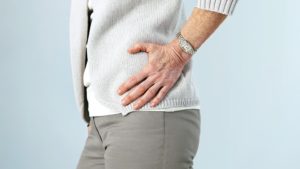 When something goes wrong in the hip joint there are a lot of possible culprits… bones, muscles, tendons, ligaments, and more. Just like low back pain, the sources of hip pain can be difficult to pinpoint. When you have hip osteoarthritis, the pain is coming from inside the joint. With hip bursitis, pain is coming from the outside. Hip osteoarthritis also develops commonly in the middle-aged and elderly. Hip osteoarthritis occurs when the cartilage in the hip joint wears down with age.
When something goes wrong in the hip joint there are a lot of possible culprits… bones, muscles, tendons, ligaments, and more. Just like low back pain, the sources of hip pain can be difficult to pinpoint. When you have hip osteoarthritis, the pain is coming from inside the joint. With hip bursitis, pain is coming from the outside. Hip osteoarthritis also develops commonly in the middle-aged and elderly. Hip osteoarthritis occurs when the cartilage in the hip joint wears down with age.
Osteoarthritis or Hip Bursitis?
Osteoarthritis and bursitis have similar symptoms, but very different reasons for causing pain.
- Hip Osteoarthritis – Osteoarthritis occurs when inflammation and injury to a joint cause a breaking down of cartilage tissue. In turn, that breakdown causes pain, swelling, and deformity. Hip osteoarthritis occurs when the slippery, protective cartilage in the hip joint thins or disappears. Cartilage is a firm, rubbery material that covers the ends of bones in normal joints. It is primarily made up of water and proteins. The primary function of cartilage is to reduce friction in the joints and serve as a “shock absorber.” The shock-absorbing quality of normal cartilage comes from its ability to change shape when compressed. Although cartilage may undergo some repair when damaged, the body does not grow new cartilage after it is injured. When the cartilage is damaged, there can be painful friction between the bones that make up the hip’s ball and socket. bone spurs may form as the cartilage degenerates, which can make the bone on bone friction worse.
- Hip Bursitis – Bursitis is inflammation of the bursa. There are two major bursae in the hip that typically become irritated and inflamed. One bursa covers the bony point of the hip bone called the greater trochanter. Inflammation of this bursa is called trochanteric bursitis. Throughout the body, bursae provide cushion and reduce friction between bones and the soft tissues that run over them during joint movement. Another bursa — the iliopsoas bursa — is located on the inside (groin side) of the hip. When this bursa becomes inflamed, the condition is also sometimes referred to as hip bursitis, but the pain is located in the groin area. Because of its tendency to share symptoms with hip osteoarthritis and other hip conditions. Greater trochanteric bursitis often is called the “great mimicker” because symptoms are similar to those of other conditions, including osteoarthritis or lower back pain.
Comparing Arthritis and Bursitis Symptoms
Is your hip pain caused by osteoarthritis, bursitis, or something else? Bursitis, Osteoarthritis (OA), and Rheumatoid Arthritis (RA) have some similar symptoms, but the long-term outlook and treatment plans are different. Most cases of bursitis can be treated and go away. OA and RA are both chronic, though you may go through periods of lessened symptoms and flares of symptoms. A closer look at the symptoms of osteoarthritis and bursitis may provide you clues.
- Osteoarthritis Symptoms – Usually the pain originates from the inside of the hip joint and it is also felt in the groin and thigh and occasionally in the buttock, the hip joint will have decreased range of motion and joint stiffness. When joints create a grinding or popping sound or sensation, this is known as crepitus. Crepitus occurs in osteoarthritis. Sometimes the pain will even be referred to the knee.
- Bursitis Symptoms – The pain with bursitis will be felt on the outside of the lower hip. Pain and tenderness will increase when pressure is put on the affected hip. Even laying on your side will cause discomfort.
When to See a Doctor
If you’ve been experiencing joint pain for a few weeks or longer, visit your doctor. A doctor can provide you with a definitive diagnosis and recommend treatment. You may be able to try interventions to cure bursitis, while OA and RA will need to be managed long-term. Common nonsurgical treatments for both conditions include ice or heat therapy, anti-inflammatory medications, therapeutic injections, and physical therapy. Occasionally, severe cases are treated with surgery. You should see a doctor right away if you…
- Become unable to move your joint
- Notice the joint is very swollen and the skin is overly red
- Experience severe symptoms that interfere with your ability to complete daily activities
- If you have a fever or flu-like symptoms along with joint pain. A fever may be a sign of an infection.
For persistent joint pain that is interfering with your daily activities, see a Tristate rheumatologist to make the correct diagnosis and begin the proper treatment.
Contact Us (859-331-3100) For More Information to Request an Appointment
—
 About Tristate Arthritis and Rheumatology
About Tristate Arthritis and Rheumatology
Tristate Arthritis and Rheumatology is first and largest Rheumatology practice in the Northern Kentucky area. Founded by Dr. Arthur Kunath in 1986, our rheumatology practice now consists of six doctors who are board certified in both Internal Medicine and Rheumatology and a Physician Assistant. Patients see one doctor (except in emergencies), thereby assuring continuity of care and an individualized doctor-patient atmosphere giving the physician the ability to establish personalized and detailed relationships. Our doctors have received numerous awards, including being listed as “Top Doctors” in Cincinnati Magazine, receiving the Patient’s Choice Award, the Most Compassionate Doctor Award, and the American College of Rheumatology’s “My Doc Rocks” award.
>> Learn More


